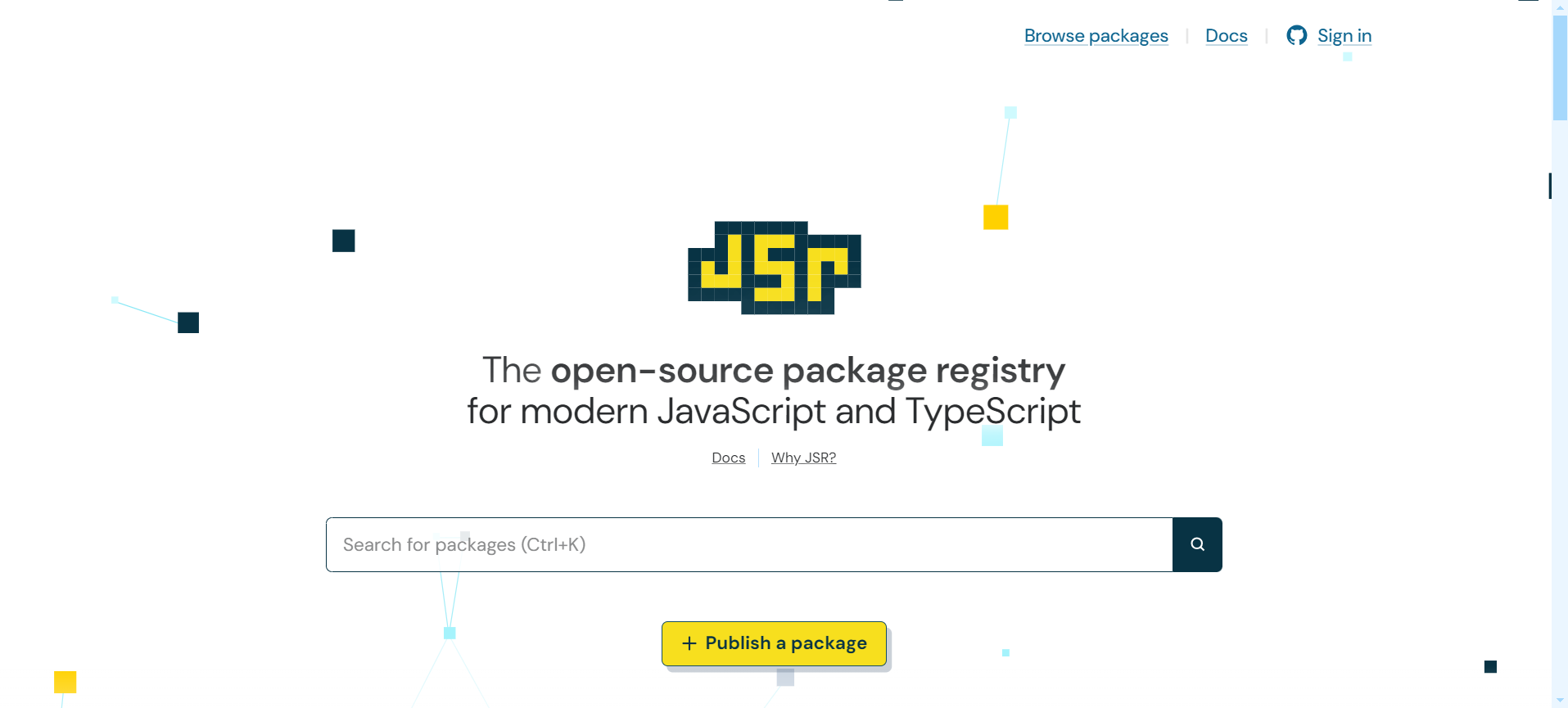As a full-stack developer with over half a decade of experience, I've witnessed the ever-evolving landscape of JavaScript and its ecosystem. From the groundbreaking introduction of Node.js to the pervasive adoption of TypeScript, each advancement has reshaped how we build and deploy applications. Recently, a new development caught my attention: JSR, the JavaScript Registry. After an in-depth exploration of its features and potential, I’m excited to share my insights and perspectives on this groundbreaking tool.
What is JSR?
JSR, or the JavaScript Registry, is an innovative package registry tailored to the modern needs of JavaScript developers. It’s free, open-source, and supports TypeScript and ES modules, ensuring compatibility with contemporary JavaScript runtimes like Deno, Node, Bun, and Cloudflare Workers. Here’s a detailed breakdown of its core features:
ESM-Only Support: JSR exclusively supports ECMAScript modules (ESM), the current web standard for modular JavaScript.
TypeScript-First Approach: Designed with TypeScript in mind, JSR streamlines the integration and enhances the development experience.
Broad Compatibility: JSR is designed to work seamlessly with Deno and npm-based projects, offering flexibility across various environments.
Installation and Usage
JSR’s simplicity and developer-friendly design make it an appealing choice for managing JavaScript packages. Here’s how you can get started:
# For Deno
deno add @example/package
# For npm and similar systems
npx jsr add @example/package
Importing and using these packages in your project is just as straightforward:
import { exampleFunction } from "@example/package";
exampleFunction();
Publishing your own modules is equally hassle-free, whether you're using Deno or npm-like systems:
# Publish with Deno
deno publish
# Publish with npm-like systems
npx jsr publish
The Positives
Seamless TypeScript Integration: JSR’s TypeScript-first approach is a boon for developers who have adopted TypeScript. It eliminates the need for manual type declaration management, ensuring that the packages you use are fully compatible with TypeScript.
Adherence to Modern Standards: By exclusively supporting ES modules, JSR aligns with the latest web standards, paving the way for future-proof development practices. This reduces friction when adopting new technologies and ensures compatibility with modern JavaScript environments.
Enhanced Documentation and Quality Metrics: JSR automatically generates comprehensive API documentation and assigns quality scores to packages. These scores, based on factors like documentation completeness and runtime compatibility, help developers quickly assess the reliability and usability of packages.
Community-Driven and Open Source: JSR’s commitment to being free and open-source fosters a collaborative environment. The initiative to involve community moderators and contributors in governance enhances transparency and community involvement.
The Negatives
Transition Challenges: For developers deeply embedded in the npm ecosystem, transitioning to JSR might present some challenges. Existing workflows, CI/CD pipelines, and integrations would need to be updated, and there might be a learning curve associated with the new platform.
Limited Package Availability: As JSR is still in its public beta phase, the number of available packages is limited compared to npm's vast repository. This could pose a temporary drawback, especially if you rely on less common packages.
Early-Stage Software Stability: Being a new entrant, JSR might have undiscovered bugs and stability issues. While the development team seems committed to addressing these, early adopters need to be prepared for potential hiccups.
Deep Dive: Publishing and Consuming Modules
Publishing a Module:
JSR simplifies the process of publishing TypeScript modules. Here’s an example of creating and publishing a simple module:
Create your module files:
jsr.jsonfor metadatamod.tsfor your module’s implementationREADME.mdfor documentation
// jsr.json
{
"name": "@example/yassify",
"version": "1.0.0",
"exports": "./mod.ts"
}
// mod.ts
/**
* Yassify a string of text by appending emojis.
*
* @param str The string of text to yassify.
* @returns A string of text with emojis appended.
*/
export function yassify(str: string): string {
return `${str} 💅✨👑`;
}
# yassify
Use `yassify` to apply advanced beauty filters to any string of text.
## License
MIT
- Publish your module:
deno publish
Consuming a Module:
To consume the newly published module, follow these steps:
- Install the module:
npx jsr add @example/yassify
- Use the module in your project:
import { yassify } from "@example/yassify";
console.log(yassify("Hello, world!")); // Outputs: Hello, world! 💅✨👑
The Future of JavaScript Package Management
JSR represents a significant leap forward in the JavaScript package management space. Its TypeScript-first design and adherence to modern standards address many of the current pain points in the ecosystem. Here’s why I believe JSR has the potential to shape the future of JavaScript development:
Efficiency and Developer Experience: By automating type declarations and documentation, JSR significantly enhances the developer experience, making it easier to maintain high-quality codebases.
Community and Open Source Ethos: The open-source nature of JSR and its community-driven governance model foster an inclusive environment where developers can contribute, collaborate, and innovate.
Future-Proofing Development: As JavaScript continues to evolve, JSR’s alignment with the latest standards ensures that it remains relevant and useful, reducing the need for constant retooling.
conclusion
JSR is poised to revolutionize how we manage JavaScript packages. Its thoughtful design and commitment to modern standards make it a compelling choice for developers looking to streamline their workflows and embrace the latest advancements in the JavaScript ecosystem. While there are challenges to consider, particularly for those entrenched in the npm ecosystem, the potential benefits of adopting JSR are substantial.
In summary, JSR offers a fresh and innovative approach to managing JavaScript packages. Its modern, TypeScript-centric design addresses many of the pain points developers face today. While the transition to a new tool always comes with challenges, the promise of a smoother, more integrated development experience makes JSR a noteworthy development in the JavaScript ecosystem. Whether you’re an early adopter or cautiously optimistic, keeping an eye on JSR and experimenting with it could provide significant benefits for your projects.
As a full-stack developer, I’m excited about the possibilities that JSR brings to the table. It has the potential to enhance productivity, improve code quality, and foster a more collaborative and innovative community. If you’re eager to stay ahead of the curve and leverage the latest tools in our field, JSR is definitely worth exploring.

